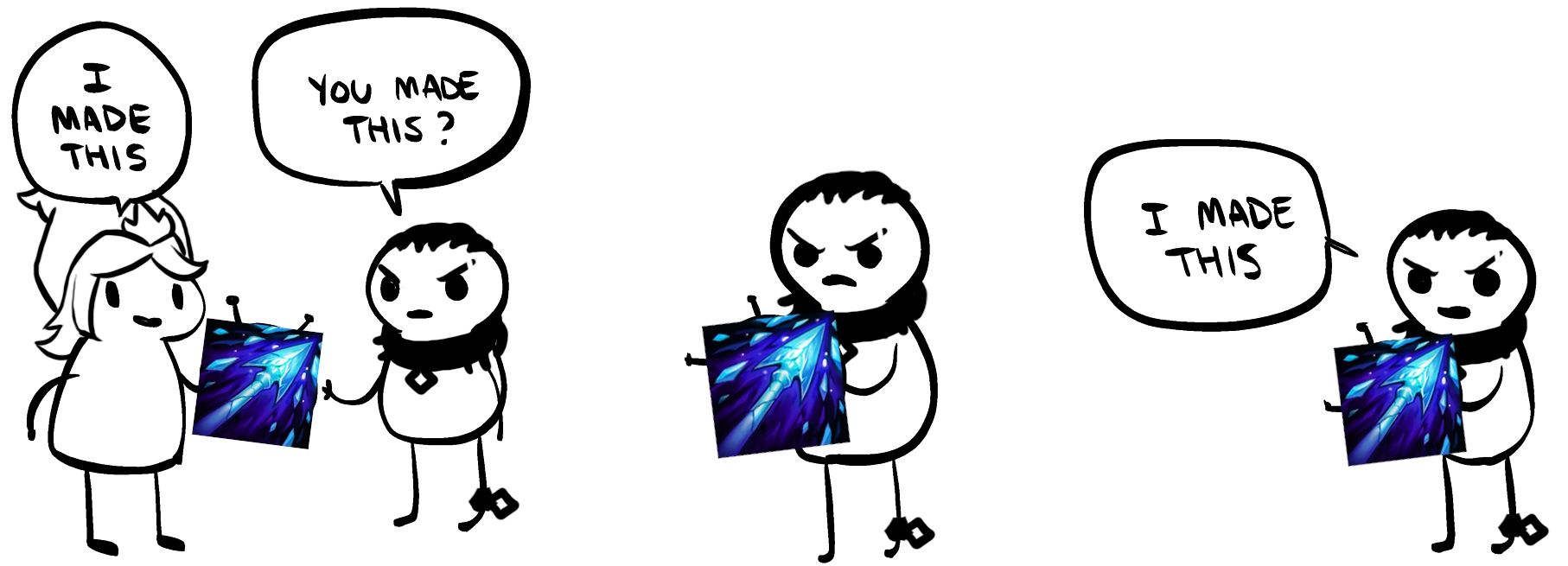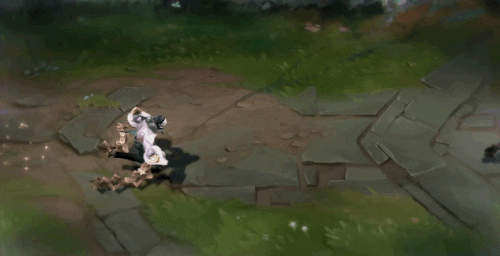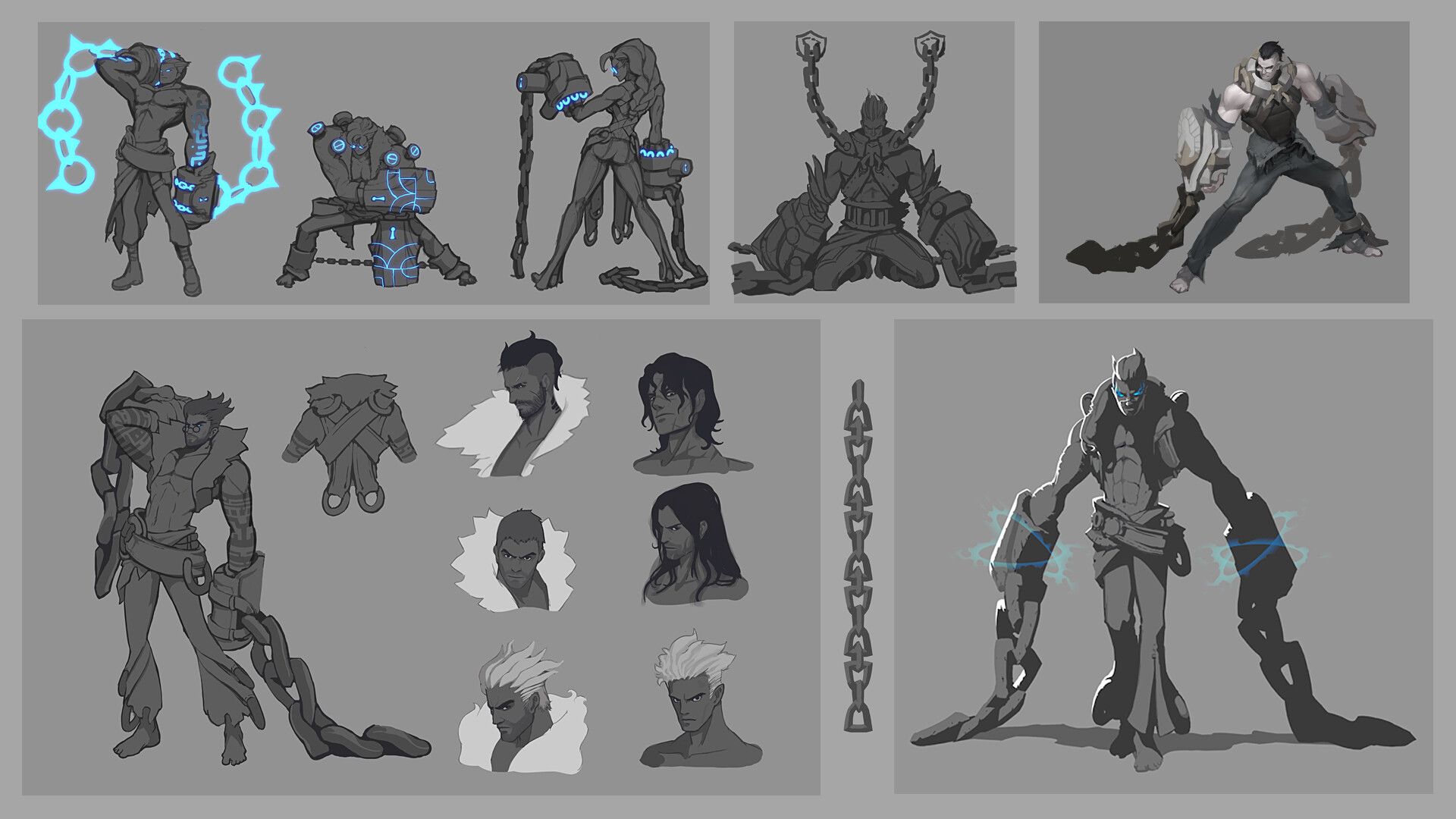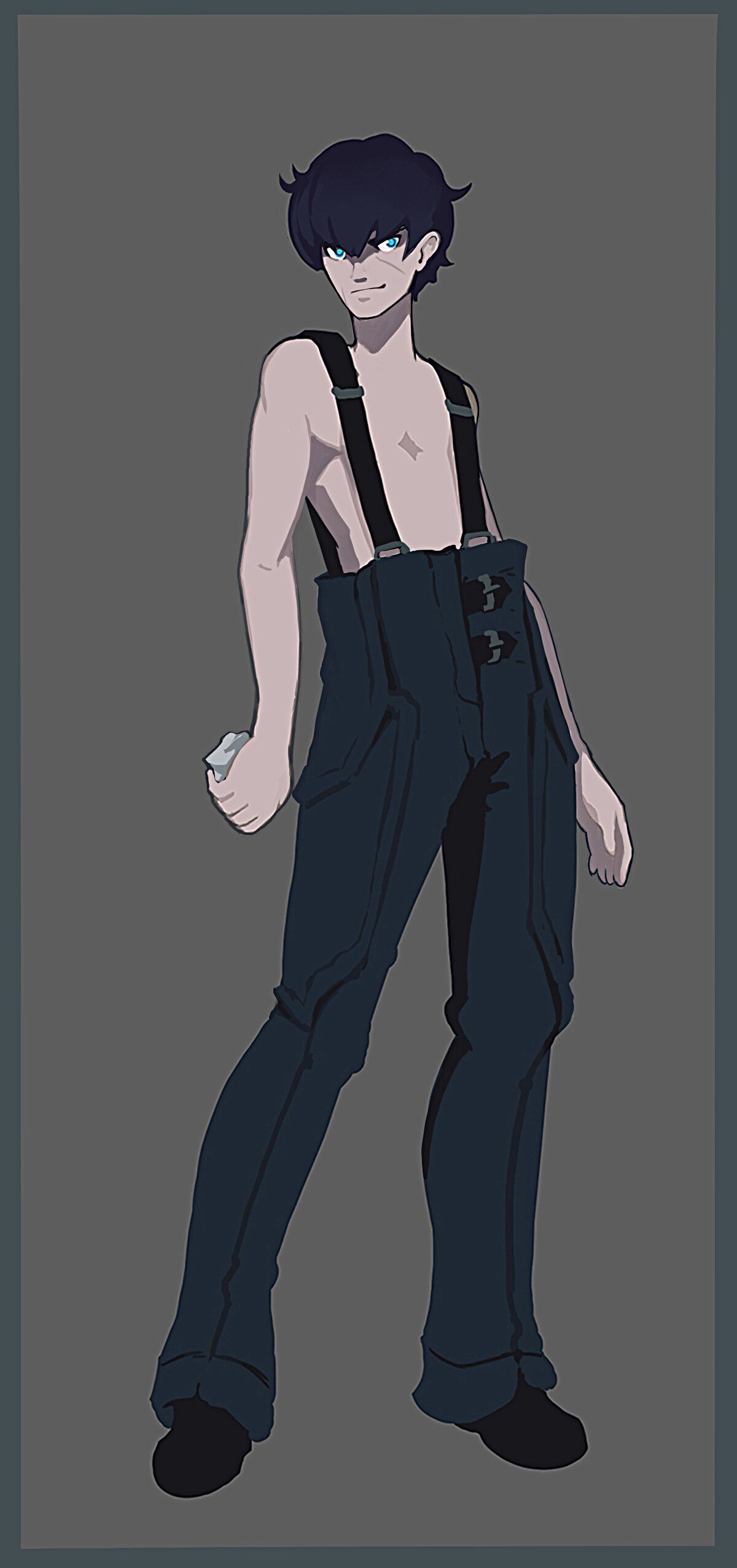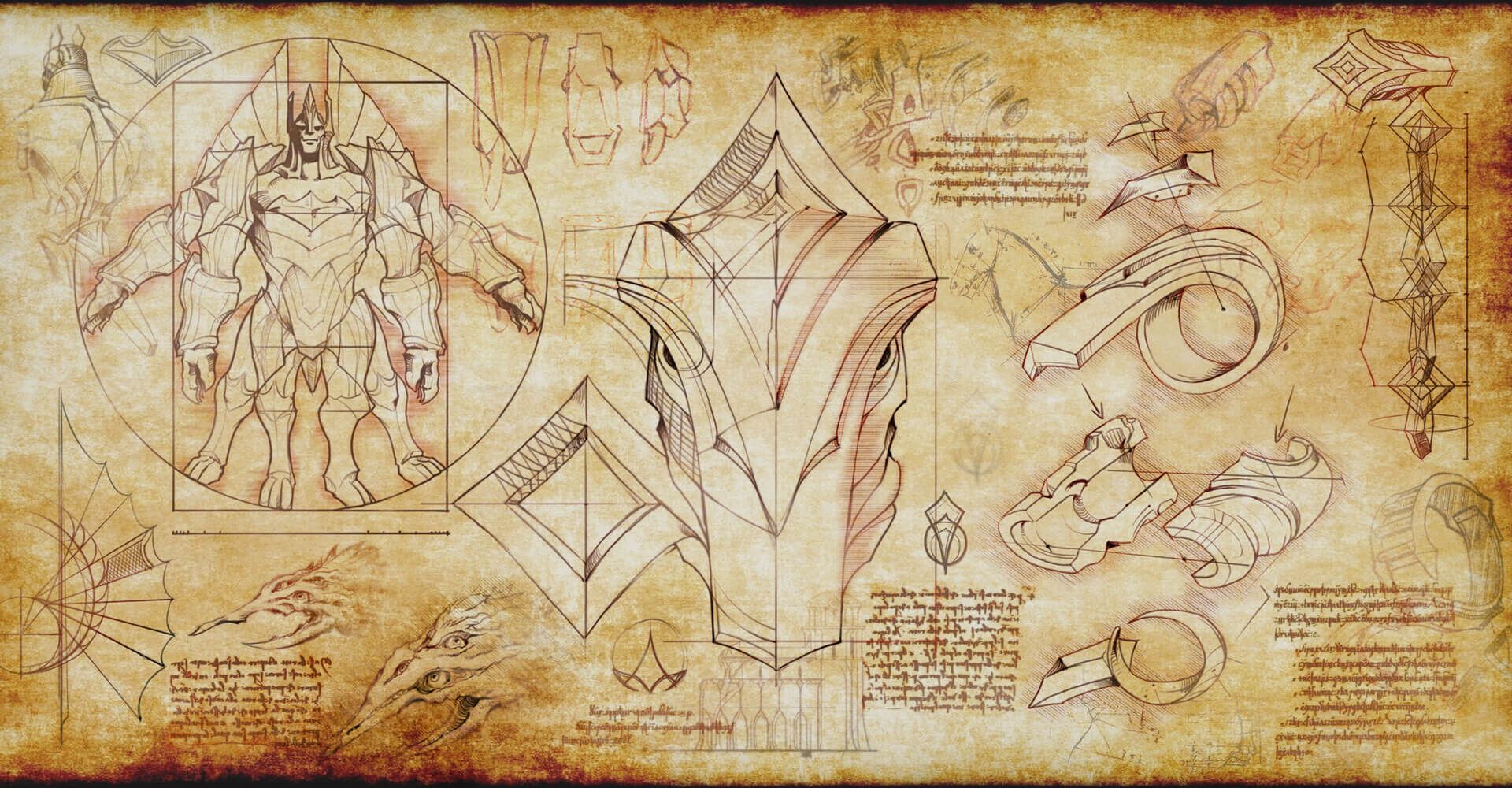ORIGINS: Sylas
Sylas of Dregbourne, everyone’s favorite ult-stealing skirmisher, is moody and mutinous—the product of a near-lifetime locked up. He’s revolutionary, resentful, stronk af, and a little bit cocky. But he didn’t start that way.
When concept artist Snuny “Kindlejack” Pinatdat first joined the Champions Team, he started working on a top lane mage—a gameplay archetype that doesn’t have many champions on the roster and might bring an influx of players to the most cursed lane.
“The original idea was a young, female champion who was cute and bubbly and fun,” he explains.
“And then we made Sylas.”
Got Your Spell
While Krinklejank explored concepts for the cute, bubbly, fun champ, senior game designer Blake “Squad5” Smith started working on the kit. He began by tinkering with an ability he’d wanted to make for years: spell-stealing.
But there was one small enormous problem: League wasn’t coded for spell-stealing abilities.
“I didn’t think that it was technically possible because I had asked some engineers before and they were like ‘No, don’t do that, you’re crazy,’” Squad5 recalls. But after securing a soft maybe from some other engineers, he took off running with the spell-stealing concept.
“I had a super, super rough version of the spell that would become Sylas’ R and I had to set it up in a really janky way. But pretty much immediately after the first internal playtest we knew that the ability was awesome.”
Meme to explain Sylas' ultimate based on the original by Anthony Clark.
Regardless of how fun it was to play, actually building the ultimate became something of an engineer’s nightmare. For spell-stealing to work in League, the engineering team had to do a major overhaul of every ability in the game.
The nitty gritty of the challenge requires big engineer brain, but to put it simply, up until that point spells in League weren’t set up in a way where another champ could access them. Spells were essentially hardbound to each champion.
Before Sylas, the concept of an ability—how a spell runs from start to finish—didn’t really exist in League’s backend. Most spells existed within an individual champion’s scripts, so the game engine didn’t understand each ability on its own. Spell passives weren’t a self-contained concept either. So for abilities and their accompanying passives to transfer over to Sylas, the engineering team needed to build out those systems and implement them for every champion in the game.
“The game engine essentially needed to put each spell into a capsule and say ‘Everything in here is what you need, and nothing else, and I know how long you need it,’” explains game engineer Chris “Griftrix” Laubach.
It was a massive undertaking. Essentially every spell in the game had to get refactored, which was a lot on its own, but there was also the added complexity of shapeshifters like Nidalee and Jayce, and the fact that some spells scale off AD while Sylas uses AP.
Sylas’ engineering challenge created better standards for League’s engine in the long run, and it paved the way for Viego and Ultimate Spellbook.
“Every time I see the engineers that helped me on Sylas’ ultimate, I still apologize and thank them to this day,” Squad5 laughs.
But the engineering team’s work paid off in a huge way. Beyond becoming Sylas’ signature spell and pushing the boundaries of abilities in League, Sylas’ ultimate also helped the team devise the look and personality of the champion.
Demacia’s Dark Secret
At this point, the plucky top lane mage was still the direction the team was headed, and the initial plan was to use the spell-stealing ability for good. But they quickly realized stealing spells doesn’t feel very heroic—for Sylas or his opponents.
“When we started playtesting , the very first feedback that we got on this spell was ‘This feels mean, this feels really mean,’” Squad5 said. “There was a smugness to it, like ‘I just feel good killing you with your thing because f*&^ you.’”
So the team went back to the drawing board with the goal of creating a darker character.
The team started to narrow in on a prisoner concept. Years earlier, Anthony “Ant in Oz” Reynolds Lenne pitched the idea that Demacia kept mages in secret prisons. The concept was revived for Sylas.
They toyed around with ideas like a tricksy sorceress or a zealous Mageseeker. A pitch for a braggadocious Houdini-esque character who could master any spell and escape any prison got some traction, but it started to feel sleightly corny.
That’s when narrative writers John “JohnODyin" O’Bryan and Rayla “Jellbug” Heide came up with the idea of a prisoner minus the escape artist abilities—a powerful mage locked up in Demacia for fifteen years.
“We started to riff on the ideas of Petricite and Demacia as a country,” Kanklejazz says. “What if Sylas was something that Demacia decided to bury?”
Petricite is a white stone-like material that originates from ancient, fossilized trees. Demacia uses Petricite in its architecture to protect against magic. While most Demacians believe it simply suppresses magic, its main property is absorbing and storing magic.
Demacia is known as a city of light and order, the home of beloved champs like Garen, Jarvan, and Lux. But the effort to drive magic from its borders—however well-intentioned—left a revolution seething beneath all that Petricite. A revolution that only needed an intelligent, charismatic leader to get off the ground.
Enter Sylas.
Sylas originates from a lesser region of Demacia, born with the magical ability to see hidden sorcery and redirect others’ magical powers. At a young age, he even helped the Mageseekers root out magical people in hiding.
But after an incident that left two Mageseekers and a young girl dead, Sylas was locked up and left to rot in a Demacian prison, chained with Petricite shackles.
“I immediately jumped on the idea of chains and shackles as the key weapon and imagery. I really liked that the ultimate ability was taking the power of your enemy and turning it against them,” explains Kinderjab. “And the chains are kind of a metaphor for that—taking the symbols of your oppression and using them to gain your freedom.”
But joke’s on you, NPC guards. The Petricite shackles only made Sylas stronger, allowing him to store and control his magic.
“Without shackles his magic just sprays uncontrollably like water from a busted hydrant,” says JohnODyin. “The shackles gave him a battery for it, like a control valve where he could store it, use it at will, and focus it.”
As the concept art began to take shape, Kinojam meticulously thought through the details of Sylas’ life. What does he eat in prison? Why are his pants so tight? How is he so buff? (He’s fed well by the Demacians but is a drama queen about it; they’re the same pants he was wearing when he was first imprisoned at a young age; compound lifts with outrageously oversized chains.)
Sylas’ color scheme is the same as Garen’s, but desaturated, to show that his love for Demacia has faded. And he’s even branded with a Demacian Mageseekers’ symbol, a scar he’ll carry for life.
Sylas’ muscle-bound prisoner persona fed into his gameplay—and vice versa. As playtesting progressed, Squad5 realized many stolen ultimates worked best if Sylas could go all in. Making Sylas a melee skirmisher with some mobility instead of a traditional mage allowed him to use spells like Amumu’s ult without getting instantly deleted.
Sylas was bespectacled for a while during development. The glasses were to help him read all of the books and manuscripts Lux brought him. The idea of giving Sylas a pet lizard was also on the table for a hot second.
Sylas’s story becomes intertwined with Lux’s when she wanders down to the dungeons of Demacia. She starts bringing Sylas books and manuscripts, one of which reveals the powers of Petricite, the key for Sylas to finally escape.
And his escape sparks a rebellion within Demacia.
The Future of Demacia and Sylas
For the narrative team, the story of a revolutionary within a society like Demacia came together pretty seamlessly. The kingdom’s persecution of mages created a powder keg just waiting for a spark.
“Once we knew we had this character in a place where magic was outlawed, he sort of wrote himself,” JohnODyin said. “Who would that guy be? What’s the logical conclusion of a person who is oppressed by that system and has to fester in it? What would he become? And what would he be to other people who are in his position? History is full of examples, so you don’t have to look far. To me, the fun part about Sylas was that we’re asking a question about Demacia that doesn’t really have a good answer.”
Sylas’ escape rips the idealized, static version of Demacia wide open. The King of Demacia, Jarvan IV’s father, is killed in the wake of Sylas’ breakout, leaving the kingdom in disarray. Sylas begins recruiting followers—many exiled mages—to stoke his revolution. He then travels to the Freljord in the hopes of gathering more allies and finding powerful, ancient magic. And his story only continues to unfold.
Though he strives to bring down the Demacian monarchy, his status as a villain is ambiguous at best. His existence adds much-needed complexity to Demacia.
“No disrespect to Garen or Lux mains, but Demacia needed some sort of conflict,” JohnODyin says. “It can’t just be that really simplistic chivalry idea. It can’t exist in a vacuum; there has to be something for it to struggle with internally.”
And his story pushed the whole of Runeterra’s story forward, Squad5 explains.
“It almost feels like around the time that Sylas came out, we started to be a little more comfortable as a company, as an IP, actually having some things move forward and change.”
So where will Sylas’ story take us next? Is he really—as he so confidently claims—the true Demacia? We’ll just have to wait and see.


